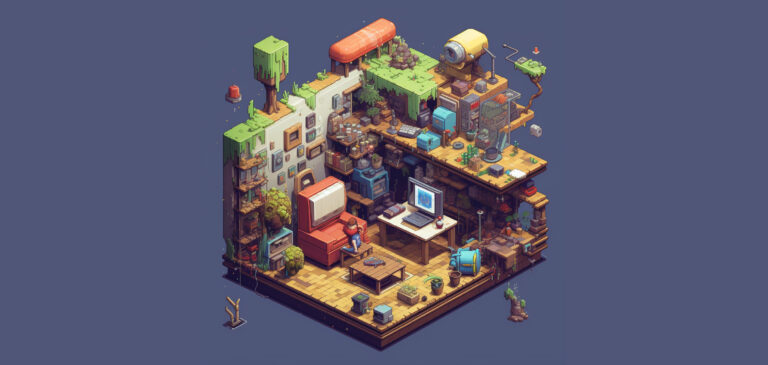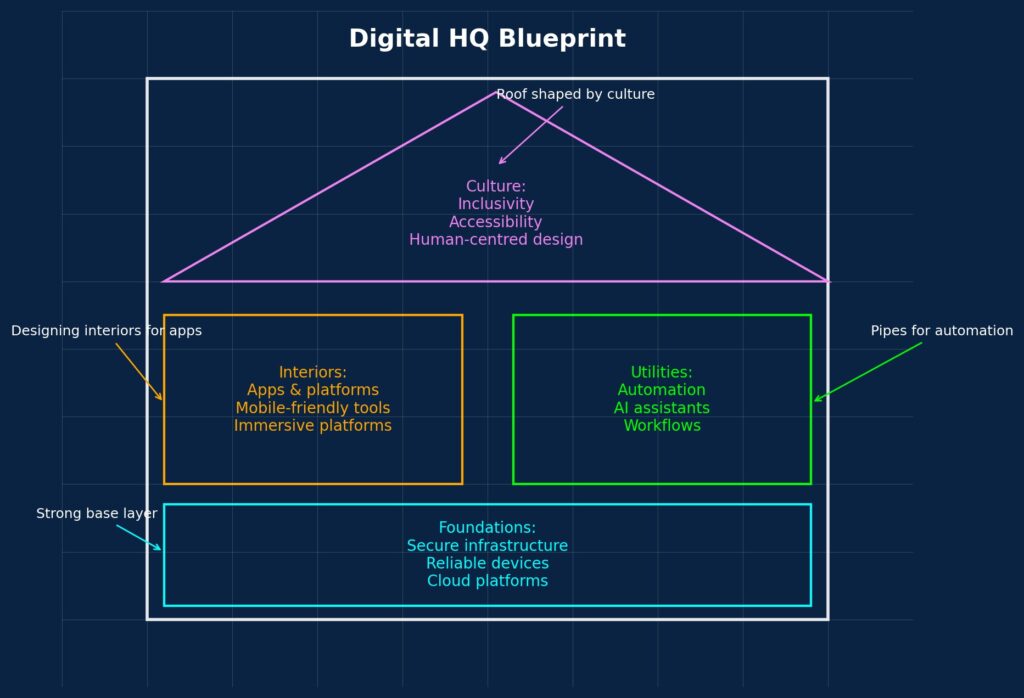
Digital Workplace Design: The Blueprint for Your Next HQ
Think of your workplace as a building. It needs solid foundations, walls to give it shape, interiors to make it welcoming, and hidden utilities to keep everything running. Digital workplace design works in much the same way. Leaders today aren’t just shopping for software.
They’re acting like architects, shaping digital headquarters that bend with change, stand firm under pressure, and put people first.
In the section ahead, we’ll walk through the digital blueprint, exploring the foundations, interiors, utilities, and culture that together build a resilient digital HQ.
Foundations: Building strong infrastructure
No structure lasts without strong foundations. In a digital workplace strategy & design, the foundation is infrastructure. This means secure networks, cloud platforms, and reliable devices.
Strong foundations ensure stability. Without them, even the best digital workplace services crumble. Video calls lag, files vanish, and trust evaporates. Employees need confidence that the structure won’t collapse under daily use.
Cloud computing has become the concrete base of digital workplace transformation. It provides flexibility, scalability, and cost efficiency. A resilient digital HQ relies on these foundations to handle routine traffic and unexpected surges.
Interiors: Apps and platforms shaping the experience
Infrastructure gives a workplace its floor and walls, but the interiors make it livable. In a digital workplace, apps and platforms play the same role. They shape how people sit, move, and connect every day.
Let’s take a look at how the right digital “interiors” make all the difference:
🧩 Interiors: Apps and platforms shaping the experience
Infrastructure is your floor and walls. Apps are the interiors of digital workplace design. They shape how people sit, move, and connect every day.
🧰 Essentials
- Video, chat, and shared docs that work together.
- Mobile-friendly collaboration apps for work on the move.
- Project boards and whiteboards for ideas and planning.
🎯 What to prioritise
- Simple onboarding and frictionless sign-in.
- Strong integrations to reduce context switching.
- Accessibility: captions, low bandwidth, keyboard support.
🌐 Immersive and modular
Use immersive collaboration tools where they truly add value.
Treat them like modular interiors for workshops and creative sprints.
🚩 Red flags
- Too many tools and duplicate features.
- Mobile apps missing key functions.
- Licences unused for months; adoption below 60%.
🧭 Quick audit (five questions)
- Can people start, share, and decide in one place?
- Does mobile deliver the same core value?
- Are meetings searchable with notes and actions?
- Do tools reduce handoffs and context switching?
- Is the experience inclusive for everyone?
Think like an interior designer. Aim for harmony, not clutter. Balance drives a better digital workplace experience.
Utilities: Automation powering the unseen
Every building has utilities, water, power, and heating. You rarely see them, but you feel their absence instantly. In a digital workplace, utilities equal automation.
Automation powers workflows behind the scenes. From AI transcription to automatic scheduling, these utilities keep the workplace running smoothly. Remote work collaboration tools with built-in automation reduce manual effort and save time.
When automation works well, employees barely notice it. Like electricity, it simply flows. But when it breaks, frustration spreads quickly. That’s why utilities in digital workplace services need careful planning and constant monitoring.
Culture: Designing for people, not just function
Architecture isn’t only about walls and windows. It’s about how people feel inside a space. The same applies to digital workplace design.
A workplace filled with tools but lacking culture is like a beautiful building that feels cold. Leaders must weave culture into design choices. For example, hybrid work technology should support equal participation, not create divides between office and remote staff.
Inclusivity is part of the design brief. Captioning tools, low-bandwidth options, and mobile-first platforms ensure accessibility. This is how digital workplace solutions support fairness across diverse teams.
Balancing immersion and simplicity
One risk of digital workplace innovation is over-design. Just as architects can add unnecessary pillars, companies can overload employees with features.
Immersive collaboration tools are powerful but should serve real needs. A virtual office platform with avatars might energise a creative agency. But it may overwhelm a financial services team. Leaders must ask: Does this design improve productivity, or just look impressive?
The best digital workplace design combines immersive tools with simplicity. It offers both advanced rooms and quiet corners. Employees can choose the right environment for each task.
The blueprint for digital workplace transformation
Every architect works with a blueprint.
For businesses, the blueprint of digital workplace strategy & design includes:

Following this blueprint ensures the digital HQ grows strong, flexible, and human-friendly.
Case in point: Zoom rooms and their alternatives
When the pandemic hit, Zoom rooms turned into our everyday meeting spots. Fast forward a few years, and people are asking for something different. They want digital spaces that feel more natural, less rigid, and closer to real conversations.
- Zoom got us through, but variety now matters.
- Teams light up when they can work in 3D or with spatial audio.
- Some platforms let colleagues bump into each other, almost like hallway chats.
- Others create digital rooms that shift with the task, brainstorm, focus, or present.
The shift isn’t about replacing one tool with another. It’s more like renovating a home: every workplace chooses the layout that fits its people best.
Painting the digital HQ green
Now that everything is designed, the question is: what colour do we paint it? For many organisations, the answer is green.
Sustainability is becoming part of the blueprint. Cloud optimisation, learner apps, and efficient devices are today’s eco-friendly materials. They cut costs, reduce energy use, and lighten the digital carbon footprint.
A greener digital workplace design doesn’t just help the planet. It also supports wellbeing, making tools simpler, lighter, and easier on employees.
Think of it as extending the blueprint:
- Green foundations built on efficient infrastructure.
- Smart interiors powered by lean, well-integrated apps.
- Low-energy utilities where automation runs clean and efficiently.
- Culture that values both people and the planet.
The future of the digital HQ isn’t just connected or immersive. It’s also sustainable, designed to last, and painted green.
Distilled
Digital workplace design is no longer about collecting tools. It’s about architecture, creating spaces where people thrive. Foundations give strength. Furniture shapes interaction. Utilities keep everything flowing. And culture ties it all together. Leaders who think like architects don’t just deploy apps. They design digital workplace solutions that feel alive, purposeful, and human. That’s how the digital HQ evolves from a patchwork of tools into a true home for work.